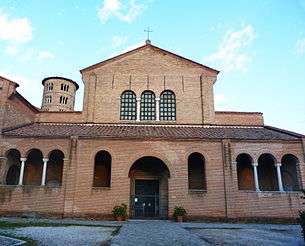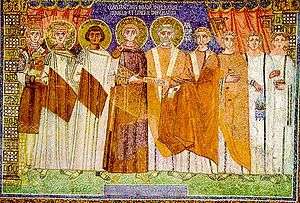Basilica of Sant'Apollinare in Classe
The Basilica of Sant' Apollinare in Classe is an important monument of Byzantine art near Ravenna, Italy. When the UNESCO inscribed eight Ravenna sites on the World Heritage List, it cited this basilica as "an outstanding example of the early Christian basilica in its purity and simplicity of its design and use of space and in the sumptuous nature of its decoration".
| Basilica of Saint Apollinaris in Classe Basilica di Sant'Apollinare in Classe | |
|---|---|
The Basilica of Sant'Apollinare in Classe | |
| Religion | |
| Affiliation | Roman Catholic |
| Province | Archdiocese of Ravenna-Cervia |
| Region | Emilia-Romagna |
| Year consecrated | 549 |
| Location | |
| Location | Ravenna, Italy |
 Shown within Italy | |
| Geographic coordinates | 44°22′49″N 12°13′59″E |
| Architecture | |
| Style | Byzantine architecture |
| Groundbreaking | 6th century |
| Official name: Early Christian Monuments of Ravenna | |
| Type | Cultural |
| Criteria | i, ii, iii, iv |
| Designated | 1996 (20th session) |
| Reference no. | 788 |
| State Party | Italy |
| Region | Europe and North America |


History
When the basilica of Sant'Apollinare was built 1500 years ago it was on the seashore at Classe, ancient home port of the Roman fleet. Due to the accumulation of silt, the coastline has moved 9 km (5.6 mi) to the east.[1] The imposing brick structure was erected at the beginning of 6th century by order of Bishop Ursicinus, using money from the Greek banker Iulianus Argentarius.[2] It was certainly located next to a Christian cemetery, and quite possibly on top of a pre-existing pagan one, as some of the ancient tombstones were re-used in its construction.
Sant'Apollinare in Classe was consecrated on 9 May 549 by Bishop Maximian and dedicated to Saint Apollinaris, first bishop of Ravenna and Classe. The Basilica is thus contemporary with the Basilica of San Vitale of Ravenna. In 856, the relics of Saint Apollinaris were transferred from the Basilica of Sant'Apollinare in Classe to the Basilica of Sant' Apollinare Nuovo in Ravenna.
The exterior has a large façade with two simple uprights and one mullioned window with three openings. The narthex and building to the right of the entry are later additions, as is the fine 9th century round bell tower with mullioned windows.
Interior
The church is on a nave and two aisles. An ancient altar in the mid of the nave covers the place of the saint's martyrdom. The church ends with a polygonal apse, sided by two chapels with apses.
The nave contains 24 columns of Greek marble. The carved capitals of the columns depict acanthus leaves, but unlike most such carvings the leaves appear twisted as if being buffeted by the wind. The faded frescos depict some of the archbishops of Ravenna, and date to the 18th century. The lateral walls are bare, but were certainly once covered with gorgeous mosaics. These were likely demolished by the Venetians in 1449, although they left the mosaic decoration in the apse and on the triumphal arch, the church's most striking features.
The upper section of the triumphal arch depicts, inside a medallion, Christ. At the sides, within a sea of clouds, are the winged symbols of the four Evangelists: the Eagle (John), the Winged Man (Matthew), the Lion (Mark), the Calf (Luke). The lower section has, at its two edges, the walls showing precious gems from which twelve lambs (symbols of the Twelve Apostles) exit. The sides of the arch show two palms which, in the Bible's symbolism, represent justice; under them are the archangels Michael and Gabriel, with the bust of St. Matthew and another unidentified saint.
The decoration of the apse date to the 6th century, and can be divided into two parts:
- in the upper one, a large disc encloses a starry sky in which is a cross with gems and the face of Christ. Over the cross is a hand protruding from the clouds, the theme of the Hand of God. At the side of the disc are the figures of Elijah and Moses. The three lambs in the lower sector symbolize the saints Peter, James and John, alluding the Transfiguration of Jesus on Mount Tabor.
- in the lower one is a green valley with rocks, bush, plants and birds. In the middle is the figure of Saint Apollinaris, portrayed in the act of praying God to give grace to his faithful, symbolized by twelve white lambs.
In the spaces between the windows are the four bishops who founded the main basilicas in Ravenna: Ursicinus, Ursus, Severus and Ecclesius, all with a book in a hand. At the sides of the apse are two 7th-century panels: the left one, which has largely been restored, portrays the Byzantine Emperor Constantine IV[3] granting privileges to an envoy of the Ravenna's archbishop. In the right panel are Abraham, Abel and Melchisedek around an altar, on which they offer a sacrifice to God.
The choice of the subject is closely linked to the fight against Arianism, as it restates the both divine and human nature of Christ, the former negated by the Arians. In addition, the representation of Apollinaris among the apostles was a legitimation to Maximian as the first bishop of a diocese directly related to the early followers of Jesus, being Apollinaris, according to the legend, a disciple of St. Peter.
The Basilica's walls are lined by numerous sarcophagi from different centuries. They attest the changes of style from the 5th to the 8th centuries: from reliefs with human figures of the Roman sarcophagi, to Byzantine symbolism, to the increasing abstraction and simplification of these symbologies.
See also
- Basilica of San Vitale, another 6th-century church in Ravenna famous for its Justinian mosaic.
- Bishop Maximianus of Ravenna, who is credited with building the Basilica
References
- Deliyannis, Mauskopf, Deborah. Ravenna in Late Antiquity. New York, NY: Cambridge University Press, January 2010, p. 13
- Roth, Leland M. (1993). Understanding Architecture: Its Elements, History and Meaning (First ed.). Boulder, CO: Westview Press. pp. 245. ISBN 0-06-430158-3.
- Agenellus of Ravenna, Deborah Mauskopf Deliyannis (trans.), The Book of Pontiffs of the Church of Ravenna (Washington D.C., 2004), p. 234, f.n. 4
Further reading
- Weitzmann, Kurt, ed., Age of spirituality: late antique and early Christian art, third to seventh century, no. 505, 1979, Metropolitan Museum of Art, New York, ISBN 9780870991790
External links

- Photos
- Ravenna Tourism site